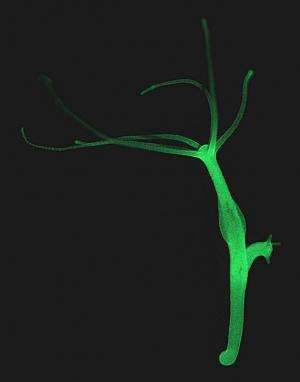Immunobiological functioning of toll-receptors revealed

The puzzle about the ancestral function of toll-receptors has been solved. For more than 25 years, researchers from medicine and biology have been studying toll-receptors, revealing functions in immune defence on the one hand and developmental biology on the other. A research team from Kiel University (Germany) is now reporting that toll-receptors have primarily served to identify germs and to control bacterial colonisation of organisms – typical immune defence functions. The study was now published online in the Proceedings of the National Academy of Sciences (PNAS) and has implications for human medical research.
"Studying cnidarians, we were able to show that toll-receptors have been involved in immune defence already in this evolutionarily old phylum and that cnidarians can therefore serve as model organisms for human immunology research", says Thomas Bosch from the Zoological Institute of Kiel University who led the project. Toll receptors exist in many animal species as well as humans. Cnidarians are convenient research objects, because they live in plain aquaria, have a simple genome, and can be examined easily in experiments. Furthermore, they live in association with few types of bacteria compared to humans. As many fundamental research questions in medicine cannot be studied directly in humans, for ethical and practical reasons, fundamental toll-receptor research can now be carried out with cnidarians instead.

With two Nobel Prizes dedicated to toll-receptor research in recent history, the topic has proven to be of major importance for science and society. In 1985, the so-called toll-receptors were first discovered as a key factor in embryonic development of the fruit fly (Drosophila melanogaster). For these findings, Christiane Nüsslein-Volhard, Edward Lewis und Eric Wieschaus were awarded the 1995 Nobel Prize for medicine. Toll-receptors again received much attention in science when researchers discovered a new function: in both the fruit fly as well vertebrate animals – evolutionarily much younger than insects – the toll-receptor helped to identify germs. Biologists Jules Hoffmann, Bruce Beutler and Ralph Steinmann received the Novel Prize for medicine for these astonishing results in 2011.
Scientifically, the subsequent question was: Which function – regulation of embryonic development or immune defence – was first in evolution? In order to solve this puzzle, scientists of Kiel University in cooperation with Max-Planck-Institute of Evolutionary Biology Plön studied the function of toll receptors in an evolutionarily very old group, cnidarians, that have been existing for more than 600 million years. The scientists compared morbidity and bacterial colonisation of regular and genetically modified polyps of the genus Hydra. The study resulted in strong evidence for immunobiological functioning of the toll-receptors, implying that developmental functions of the toll-receptor are characteristic of insects, which are evolutionarily much younger.
More information: Sören Franzenburg,Sebastian Fraune, Sven Künzel, John F. Baines, Tomislav Domazet-Loso and Thomas C. G. Bosch (2012): " MyD88-deficient Hydra reveal an ancient function of TLR signaling in sensing bacterial colonizers", Proceedings of the National Academy of Sciences.
















